2019 年 6 月英语六级真题及答案第 3 套
Part I Writing (30 minutes)
Directions:
For this part, you are allowed 30 minutes to write an essay on the
importance of motivation and methods in learning. You should write at least 150 words
but no more than 200 words.
________________________________________________________________________
________________________________________________________________________
________________________________________________________________________
Part Ⅰ Writing
The Importance of Motivation and Methods in Learning
When it comes to learning, there is a famous Chinese saying which goes "Learning
without thinking leads to confusion; thinking without learning ends in danger."
Evidently, it is meant to tell us that learning methods are as important as hard
work. I totally agree with it. Besides, I insist that in addition to diligence and
methods, motivation in learning should also be paid attention to.
As for me, motivation is an indispensable part of learning, because without
motivation, you won't start to learn at all. Even if you have started studying,
without motivation that drives you to keep going, you may easily give up when faced
with difficulties.
With motivation, we also need the right way to learn. In the learning process, hard
work is not enough. If we don't attach importance to learning methods, we may fall
into the dilemma of studying mechanically. Instead, with effective learning methods,
there will be twice the result with half the effort.
In brief, motivation and methods are critical to successful learning. Therefore,
only when we are clearly aware of this, can we achieve good learning results by making
efforts.
Part II Listening Comprehension (30 minutes)
说明:由于 2019 年 6 月六级考试全国共考了两套听力,本套真题听力与前 2 套内容相同,
只是选项顺序不同,因此在本套真题中不再重复出现。
Part III Reading Comprehension (40 minutes)
Section A
Directions:
In this section, there is a passage with ten blanks. You are required
to select one word for each blank from a list of choices given in a word bank following
the passage. Read the passage through carefully before making your choices. Each
choice in the bank is identified by a letter. Please mark the corresponding letter
�
for each item on Answer Sheet 2 with a single line through the centre. You may not
use any of the words in the bank more than once.
Steel(钢铁) is valued for its reliability 可靠性, but not when it gets cold. Most
forms of steel _A_26_abruptly 突然地、硬生生的_ become brittle (脆的)at
temperatures below about -25℃ unless they are mixed with other metals. Now, though,
a novel type of steel has been developed that resists 对抗、抵抗 _J_27_fractures
破碎、碎裂_ at much lower temperatures, while retaining 保留、留住 its strength and
toughness 韧性、韧度—without the need for expensive _B_28_additives(添加剂)_.
Steel's fragility at low temperatures first became a major concern during the Second
World War. After German U-boats torpedoed (用鱼雷攻击)numerous British ships, a
2,700-strong fleet of cheap- and-cheerful "Liberty ships" was introduced to replace
the lost vessels, providing a lifeline for the _E_29_besieged(被包围)_ British.
But the steel shells of hundreds of the ships _I_30_cracked(破裂)_ in the icy north
Atlantic, and 12 broke in half and sank.
Brittleness(脆弱、脆性) remains a problem when building steel structures in cold
conditions, such as oil rigs in the Arctic. So scientists have _N_31_strived(努
力、奋斗)_ to find a solution by mixing it with expensive metals(金属、五金) such
as nickel(镍).
Yuuji Kimura and colleagues in Japan tried a more physical(物理的、物质的、符合
自然法则的) _C_32_approach(方法)_. Rather than adding other metals, they developed
a complex mechanical (机械、力学)process involving repeated heating(加热、采
暖) and very severe(严重、严厉、严格) mechanical deformation(变形), known as
tempforming.
The resulting steel appears to achieve a combination of strength(强度)and toughness
(韧性) that is _G_33_comparable(想当、可比)_ to that of modem steels that are
very rich in alloy(合金) content(内容、含量、目录) and, therefore, very expensive.
Kimura's team intends(打算) to use its tempformed steel to make ultra-high(超
高) strength parts, such as bolts(螺栓、铆钉). They hope to reduce both the number
of _H_34_components(组建、部件)_ needed in a construction job and their weight—by
(按……计算) replacing solid(实心的、实体的) supports with _K_35_hollow(空
心的)_ tubes(管), for example. This could reduce the amount of steel needed to
make everything from automobiles(发动机) to buildings and bridges(桥梁).
A)abruptly
B)additives
C)approach
D)ardently
E)besieged
F)channel
G)comparable
H)components
I)cracked
J)fractures
�
K)hollow
L)relevant
M)reshuffled
N)strived
O)violent
Section B
Directions:
In this section, you are going to read a passage with ten statements
attached to it. Each statement contains information given in one of the paragraphs.
Identify the paragraph from which the information is derived. You may choose a
paragraph more than once. Each paragraph is marked with a letter. Answer the
questions by marking the corresponding letter on Answer Sheet 2.
The future of personal satellite(卫星) technology is here—are we ready for it?
A)Satellites used to be the exclusive playthings of rich governments and wealthy
corporations. But increasingly, as space becomes more democratized, they are coming
within reach of ordinary people. Just like drones (无人机)before them, miniature
satellites are beginning to fundamentally transform our conceptions of who gets to
do what up above our heads.
B)As a recent report from the National Academy of Sciences highlights, these
satellites hold tremendous potential for making satellite-based science more
accessible than ever before. However, as the cost of getting your own satellite in
orbit drops sharply, the risks of irresponsible use grow. The question here is no
longer "Can we?" but "Should we?" What are the potential downsides of having a slice
of space densely populated by equipment built by people not traditionally labeled
as "professionals" ? And what would the responsible and beneficial development and
use of this technology actually look like? Some of the answers may come from a
nonprofit organization that has been building and launching amateur satellites for
nearly 50 years.
C)Having your personal satellite launched into orbit might sound like an idea
straight out of science fiction. But over the past few decades a unique class of
satellites has been created that fits the bill: CubeSats. The "Cube" here simply
refers to the satellite's shape. The most common CubeSat is a 10cm cube, so small
that a single CubeSat could easily be mistaken for a paperweight on your desk. These
mini-satellites can fit in a launch vehicle's formerly "wasted space. " Multiples
can be deployed in combination for more complex missions than could be achieved by
one CubeSat alone.
D)Within their compact bodies these minute satellites are able to house sensors
and communications receivers/transmitters that enable operators to study Earth from
space, as well as space around Earth. They're primarily designed for Low Earth Orbit
(LEO)—an easily accessible region of space from around 200 to 800 miles above
Earth, where human-tended missions like the Hubble Space Telescope and the
International Space Station(ISS)hang out. But they can attain more distant orbits;
�
NASA plans for most of its future Earth-escaping payloads (to the moon and Mars
especially) to carry CubeSats.
E)Because they're so small and light, it costs much less to get a CubSat into Earth's
orbit than a traditional communications or GPS satellite. For instance,a research
group here at Arizona State University recently claimed their developmental small
CubeSats could cost as little as $3,000 to put in orbit. This decrease in cost allows
researchers, hobbyists and even elementary school groups to put simple instruments
into LEO or even having them deployed from the ISS.
F)The first CubeSat was created in the early 2000s,as a way of enabling Stanford
graduate students to design, build, test and operate a spacecraft with similar
capabilities to the USSR's Sputnik (前苏联的人造卫星).Since then, NASA, the
National Reconnaissance Office and even Boeing have all launched and operated
CubeSats. There are more than 130 currently in operation. The NASA Educational Launch
of Nano Satellite program, which offers free launches for educational groups and
science missions, is now open to U. S. nonprofit corporations as well. Clearly,
satellites are not just for rocket scientists anymore.
G)The National Academy of Sciences report emphasizes CubeSats' importance in
scientific discovery and the training of future space scientists and engineers. Yet
it also acknowledges that widespread deployment of LEO CubeSats isn't risk-free.
The greatest concern the authors raise is space debris—pieces of "junk" that orbit
the earth, with the potential to cause serious damage if they collide with
operational units, including the ISS.
H)Currently, there aren't many CubeSats and they're tracked closely. Yet as LEO
opens up to more amateur satellites, they may pose an increasing threat. As the report
authors point out, even near-misses might lead to the "creation of a burdensome
regulatory framework and affect the future disposition of science CubeSats."
I)CubeSat researchers suggest that now's the time to ponder unexpected and
unintended possible consequences of more people than ever having access to their
own small slice of space. In an era when you can simply buy a CubeSat kit off the
shelf, how can we trust the satellites over our heads were developed with good
intentions by people who knew what they were doing? Some "expert amateurs" in the
satellite game could provide some inspiration for how to proceed responsibly.
J)In 1969.the Radio Amateur Satellite Corporation (AMSAT) was created in order
to foster ham radio enthusiasts' (业余无线电爱好者)participation in space research
and communication. It continued the efforts, begun in 1961, by Project OSCAR—a U.
S. -based group that built and launched the very first nongovernmental satellite
just four years after Sputnik. As an organization of volunteers, AMSAT was putting
"amateur" satellites in orbit decades before the current CubeSat craze. And over
time, its members have learned a thing or two about responsibility. Here, open-source
development has been a central principle. Within the organization, AMSAT has a
philosophy of open sourcing everything—making technical data on all aspects of
their satellites fully available to everyone in the organization, and when possible,
�
the public. According to a member of the team responsible for FOX 1-A, AMSAT's first
CubeSat, this means that there's no way to sneak something like explosives or an
energy emitter into an amateur satellite when everyone has access to the designs
and implementation.
K)However, they're more cautious about sharing information with nonmembers, as the
organization guards against others developing the ability to hijack and take control
of their satellites. This form of "self-governance" is possible within long-standing
amateur organizations that, over time, are able to build a sense of responsibility
to community members,as well as society in general. But what happens when new players
emerge, who don't have deep roots within the existing culture?
L)Hobbyists and students are gaining access to technologies without being part of
a long-standing amateur establishment. They're still constrained by fimders, launch
providers and a series of regulations—all of which rein in what CubeSat developers
can and cannot do. But there's a danger they're ill-equipped to think through
potential unintended consequences. What these unintended consequences might be is
admittedly far from clear. Yet we know innovators can be remarkably creative with
taking technologies in unexpected directions. Think of something as seemingly benign
as the cellphone—we have microfinance and text-based social networking at one end
of the spectrum, and improvised (临时制作的)explosive devices at the other.
M)This is where a culture of social responsibility around CubeSats becomes
important-not simply to ensure that physical risks are minimized, but to engage with
a much larger community in anticipating and managing less obvious consequences of
the technology. This is not an easy task. Yet the evidence from AMSAT and other areas
of technology development suggests that responsible amateur communities can and do
emerge around novel technologies. The challenge here, of course, is ensuring that
what an amateur community considers to be responsible, actually is. Here's where
there needs to be a much wider public conversation that extends beyond government
agencies and scientific communities to include students, hobbyists,and anyone who
may potentially stand to be affected by the use of CubeSat technology.
36. Given the easier accessibility to space, it is time to think about how to prevent
misuse of satellites.I
37. A group of mini-satellites can work together to accomplish more complex tasks.C
38. The greater accessibility of mini-satellites increases the risks of their
irresponsible use.B
39. Even school pupils can have their CubeSats put in orbit owing to the lowered
launching cost.E
40. is careful about sharing information with outsiders to prevent hijacking of their
satellites.K
41. NASA offers to launch CubeSats free of charge for educational and research
purposes.F
42. Even with constraints, it is possible for some creative developers to take the
CubeSat technology in directions that result in harmful outcomes.L
43. While making significant contributions to space science, CubeSats may pose
�
hazards to other space vehicles.G
44. Mini-satellites enable operators to study Earth from LEO and space around it.D
45. AMSAT operates on the principle of having all its technical data accessible to
its members, preventing the abuse of amateur satellites.J
Section C
Directions:
There are 2 passages in this section. Each passage is followed by some
questions or unfinished statements. For each of them there are four choices marked
A), B), C) and D). You should decide on the best choice and mark the corresponding
letter on Answer Sheet 2 with a single line through the centre.
Passage One
Questions 46 to 50 are based on the following passage.
When I re-entered the full-time workforce a few years ago after a decade of solitary
self-employment, there was one thing I was looking forward to the most: the
opportunity to have work friends once again. It wasn't until I entered the corporate
world that I realized, for me at least, being friends with colleagues didn't emerge
as a priority at all. This is surprising when you consider the prevailing emphasis
by scholars and trainers and managers on the importance of cultivating close
interpersonal relationships at work. So much research has explored the way in which
collegial (同事的)ties can help overcome a range of workplace issues affecting
productivity and the quality of work output such as team-based conflict, jealousy,
undermining, anger, and more.
Perhaps my expectations of lunches, water-cooler gossip and caring,
deep-and-meaningful conversations were a legacy of the last time I was in that kind
of office environment. Whereas now, as I near the end of my fourth decade, I realize
work can be fully functional and entirely fulfilling without needing to be best mates
with the people sitting next to you.
In an academic analysis just published in the profoundly-respected Journal of
Management, researchers have looked at the concept of "indifferent relationships".
It's a simple term that encapsulates (概括) the fact that relationships at work
can reasonably be non-intimate, inconsequential, unimportant and even, dare I say
it, disposable or substitutable.
Indifferent relationships are neither positive nor negative. The limited research
conducted thus far indicates they're especially dominant among those who value
independence over cooperation, and harmony over confrontation. Indifference is also
the preferred option among those who are socially lazy. Maintaining relationships
over the long term takes effort. For some of us, too much effort .
As noted above, indifferent relationships may not always be the most helpful approach
in resolving some of the issues that pop up at work. But there are nonetheless several
empirically proven benefits. One of those is efficiency. Less time chatting and
socializing means more time working and(产出).
�
The other is self-esteem. As human beings, we're primed to compare ourselves to each
other in what is an anxiety-inducing phenomenon. Apparently, we look down on
acquaintances more so than Mends. Since the former is most common among those
inclined towards indifferent relationships, their predominance can bolster
individuals' sense of self-worth.
Ego aside, a third advantage is that the emotional neutrality of indifferent
relationships has been found to enhance critical evaluation, to strengthen one's
focus on task resolution, and to gain greater access to valuable information. None
of that might be as fun as after-work socializing but, hey, I'll take it anyway.
46. What did the author realize when he re-entered the corporate(企业) world?
A) Making new Mends with his workmates was not as easy as he had anticipated.
B) Cultivating positive interpersonal relationships helped him expel solitary
feelings.
C) Working in the corporate world requires more interpersonal skills than
self-employment.
D) Building close relationships with his colleagues(同事 was not as important as
he had ejected(驱逐).
47. What do we learn from many studies about collegial(大学的、社团的) relationships?
A) Inharmonious(不和谐、不和睦) relationships have an adverse(不利的、相反的)
effect on productivity(生产力、生产率、生产能力).
B) Harmonious relationships are what many companies aim to cultivate.
C) Close collegial relationships contribute very little to product quality.
D) Conflicting relationships in the workplace exist almost everywhere.
48. What can be inferred about relationships at work from an academic analysis?
A) They should be cultivated.
B) They are virtually(实际上、事实上、几乎) irrelevant(不相干的).
C) They are vital to corporate culture.
D) They should be reasonably intimate.
49. What does the author say about people who are socially lazy?
A) They feel uncomfortable when engaging in social interactions.
B) They often find themselves in confrontation with their colleagues.
C)They are unwilling to make efforts to maintain workplace(工作场所)relationships.
D) They lack basic communication skills in dealing with interpersonal issues.
60. What is one of the benefits of indifferent(冷漠的、中立的) relationships?
A) They provide fun at work.
B) They help control emotions.
C) They help resolve differences.
D) They improve work efficiency(效率、效益).
Passage Two
Questions 51 to 55 are based on the following passage.
�
In a few decades, artificial intelligence (AI) will surpass many of the abilities
that we believe make us special. This is a grand challenge for our age and it may
require an "irrational" response.
One of the most significant pieces of news from the US in early 2017 was the efforts
of Google to make autonomous driving a reality. According to a report, Google's
self-driving cars clocked 1,023,330 km, and required human intervention 124 times.
That is one intervention about every 8,047 km of autonomous driving. But even more
impressive is the progress in just a single year: human interventions fell from 0.8
times per thousand miles to 0.2, a 400% improvement. With such progress, Google's
cars will easily surpass my own driving ability later this year.
Driving once seemed to be a very human skill. But we said that about chess, too.
Then a computer beat the human world champion, repeatedly. The board game Go(围
棋)took over from chess as a new test for human thinking in 2016, when a computer
beat one of the world's leading professional Go players. With computers conquering
what used to be deeply human tasks, what will it mean in the future to be human?
I worry about my six-year-old son. What will his place bе in a world where machines
beat us in one area after another? He'll never calculate faster, never drive better,
or even fly more safely. Actually, it all comes down to a fairly simple question:
What's so special about us? It can't be skills like arithmetic, which machines
already excel in. So far, machines have a pretty hard time emulating creativity,
arbitrary enough not to be predicted by a computer, and yet more than simple
randomness.
Perhaps, if we continue to improve information-processing machines, well soon have
helpful rational assistants. So we must aim to complement the rationality of the
machine, rather than to compete with it. If I'm right, we should foster a creative
spirit because a dose of illogical creativity will complement the rationality of
the machine. Unfortunately, however, our education system has not caught up to the
approaching reality. Indeed, our schools and universities are structured to mould
pupils to be mostly obedient servants of rationality, and to develop outdated skills
in interacting with outdated machines. We need to help our children learn how to
best work with smart computers to improve human decision-making. But most of all
we need to keep the long-term perspective in mind: that even if computers will
outsmart us, we can still be the most creative. Because if we aren't, we won't be
providing much value in future ecosystems,and that may put in question the foundation
for our existence.
51. What is the author's greatest concern about the use of AI?
A) Computers are performing lots of creative tasks.
B) Many abilities will cease to be(不再是、停任)unique to human beings.
C) Computers may become more rational than humans.
D) Many human skills are fast becoming outdated.
52. What impresses the author most in the field of AI?
A) Google's experimental driverless cars require little human intervention.
B) Google's cars have surpassed his driving ability in just a single year.
�
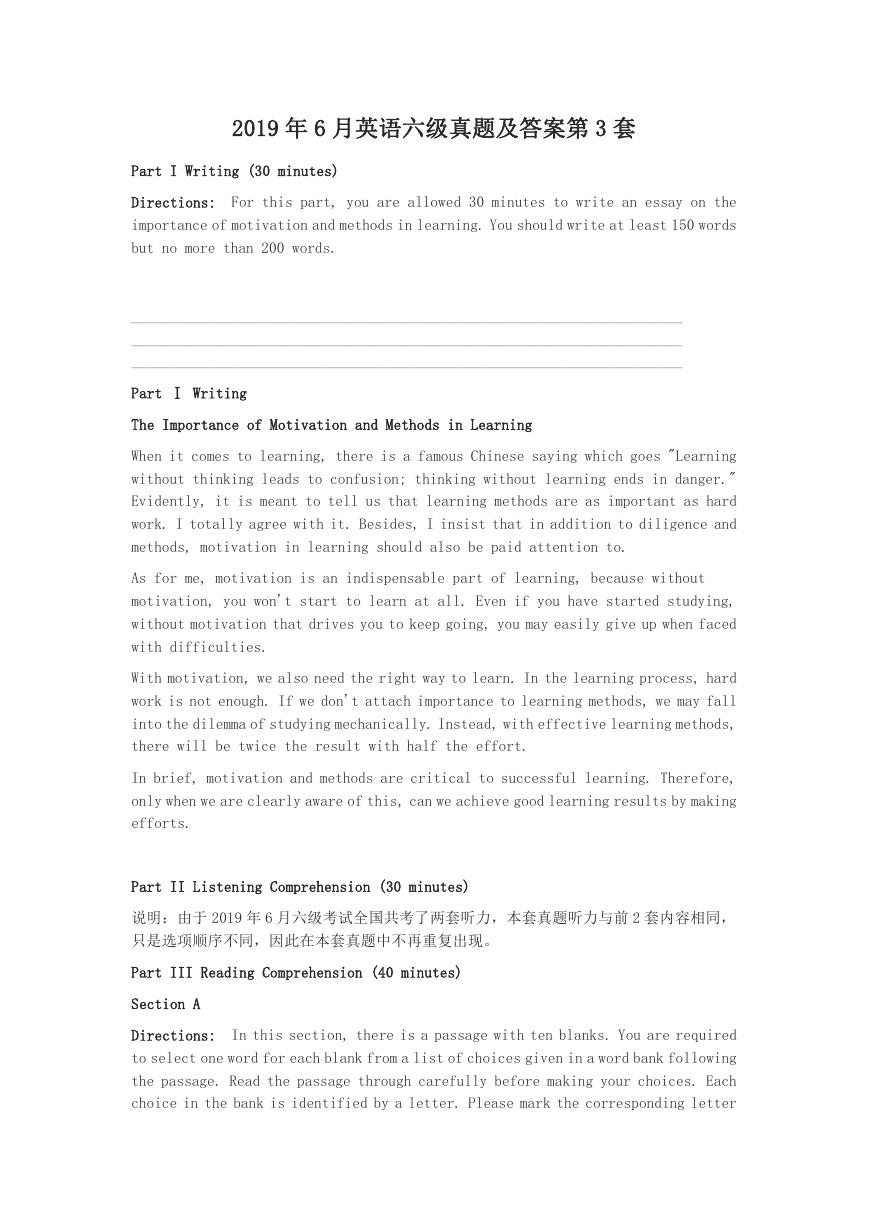
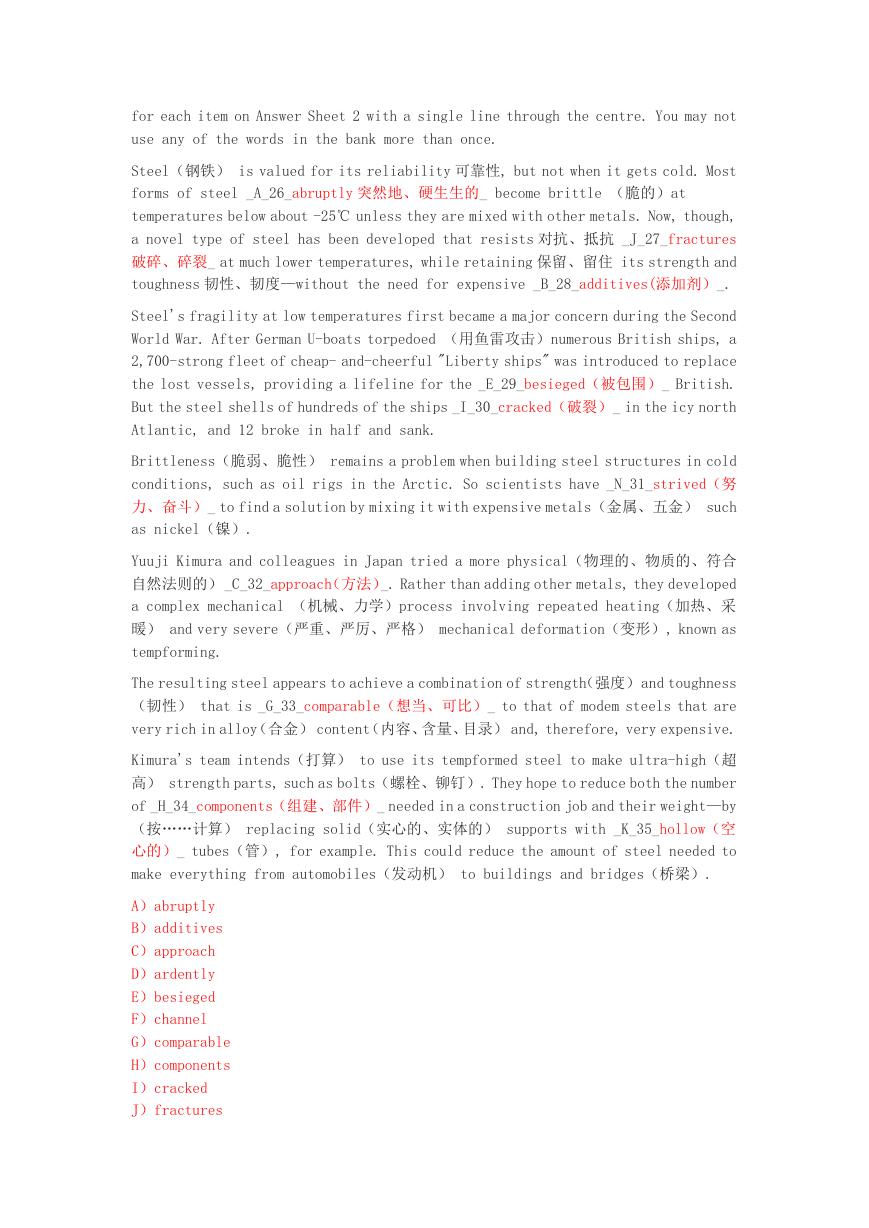
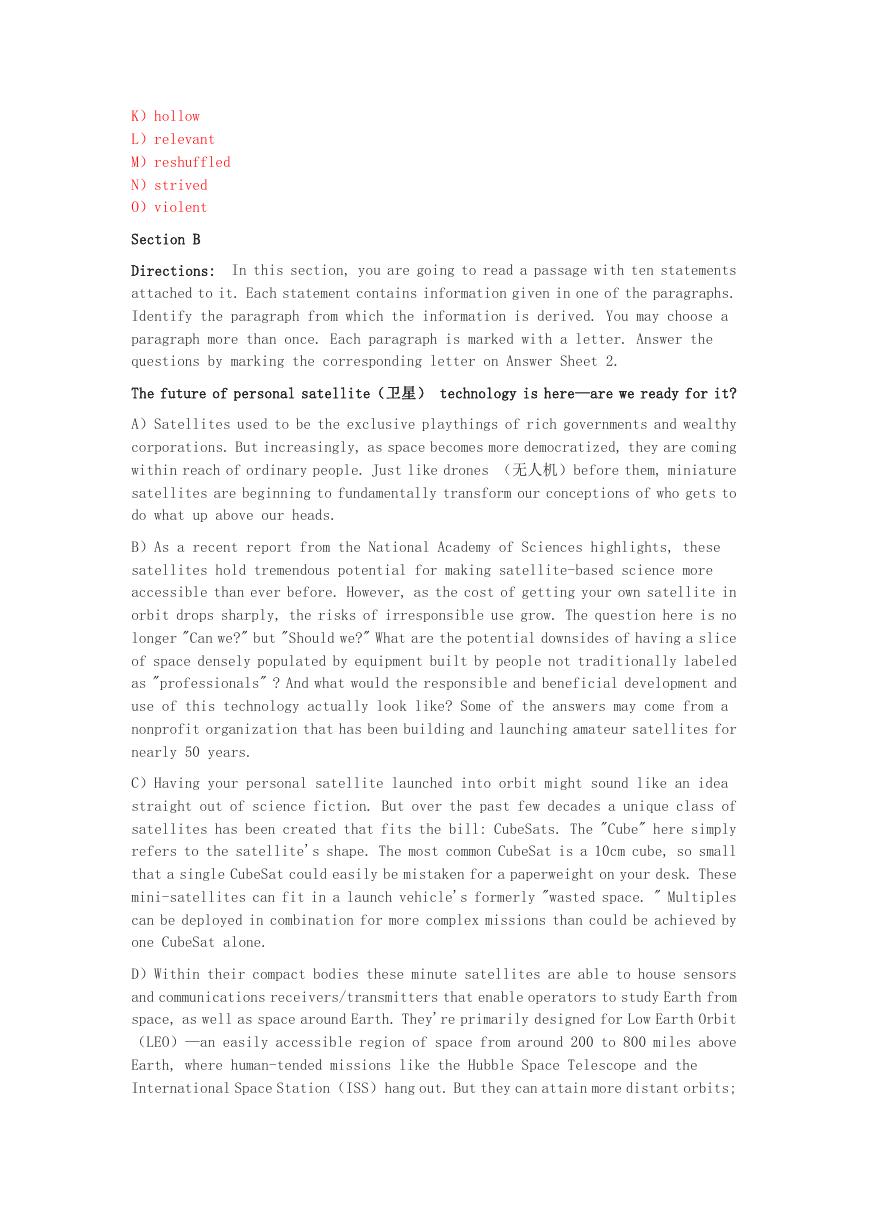
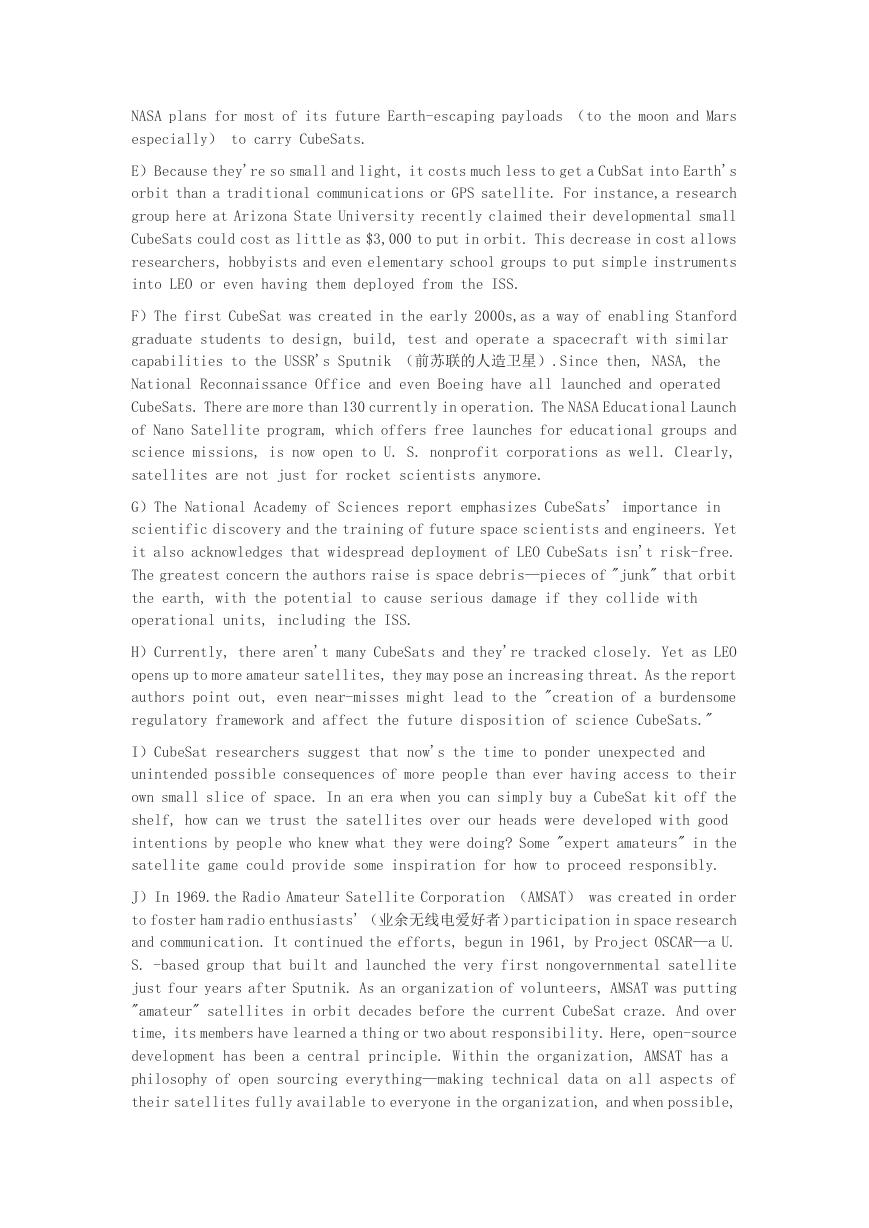
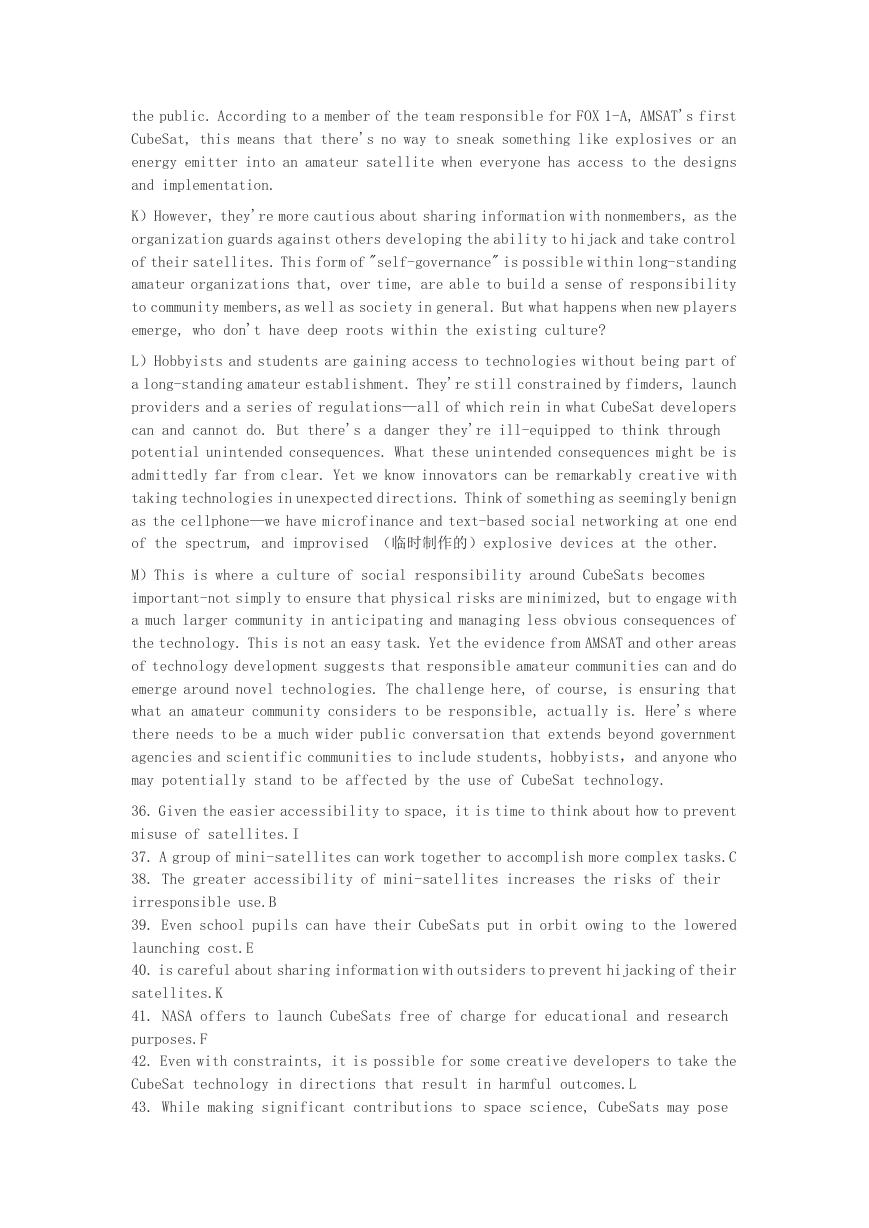

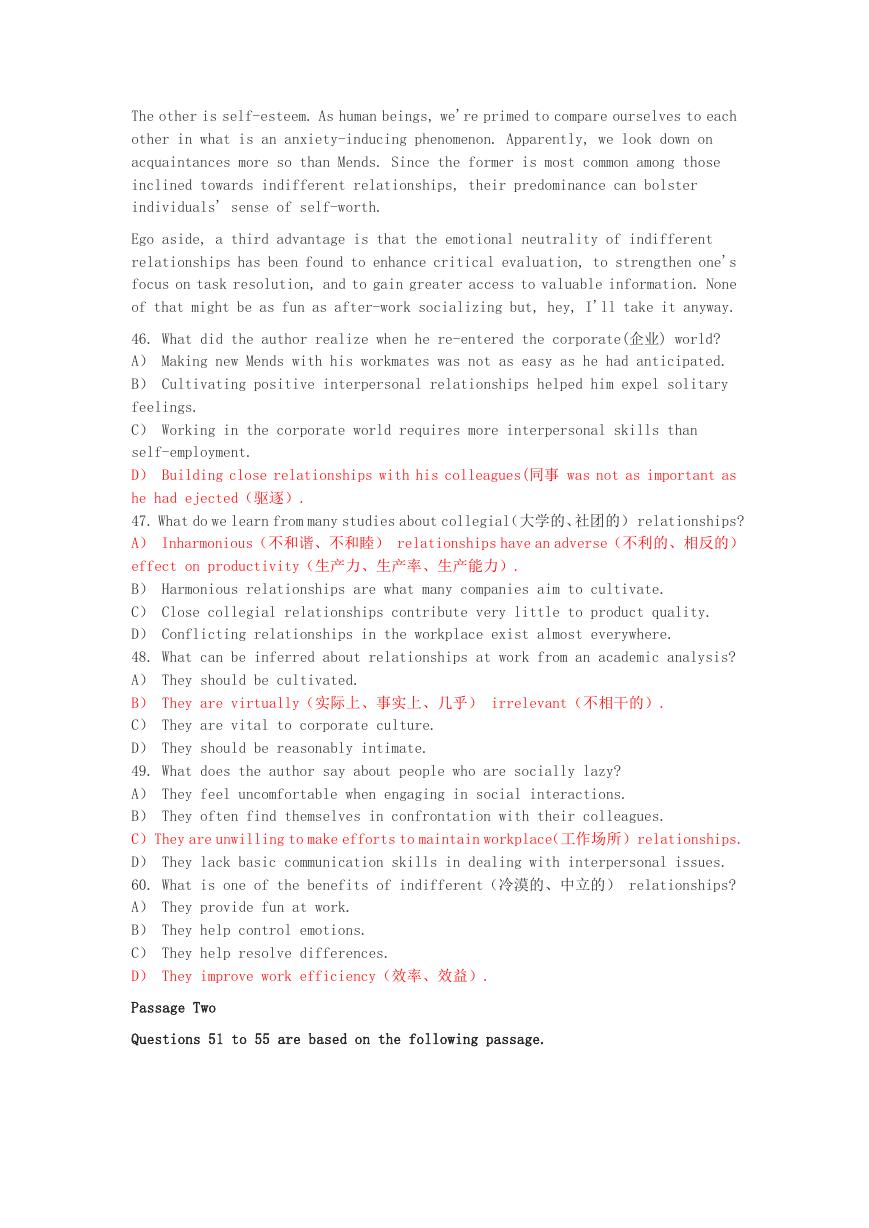
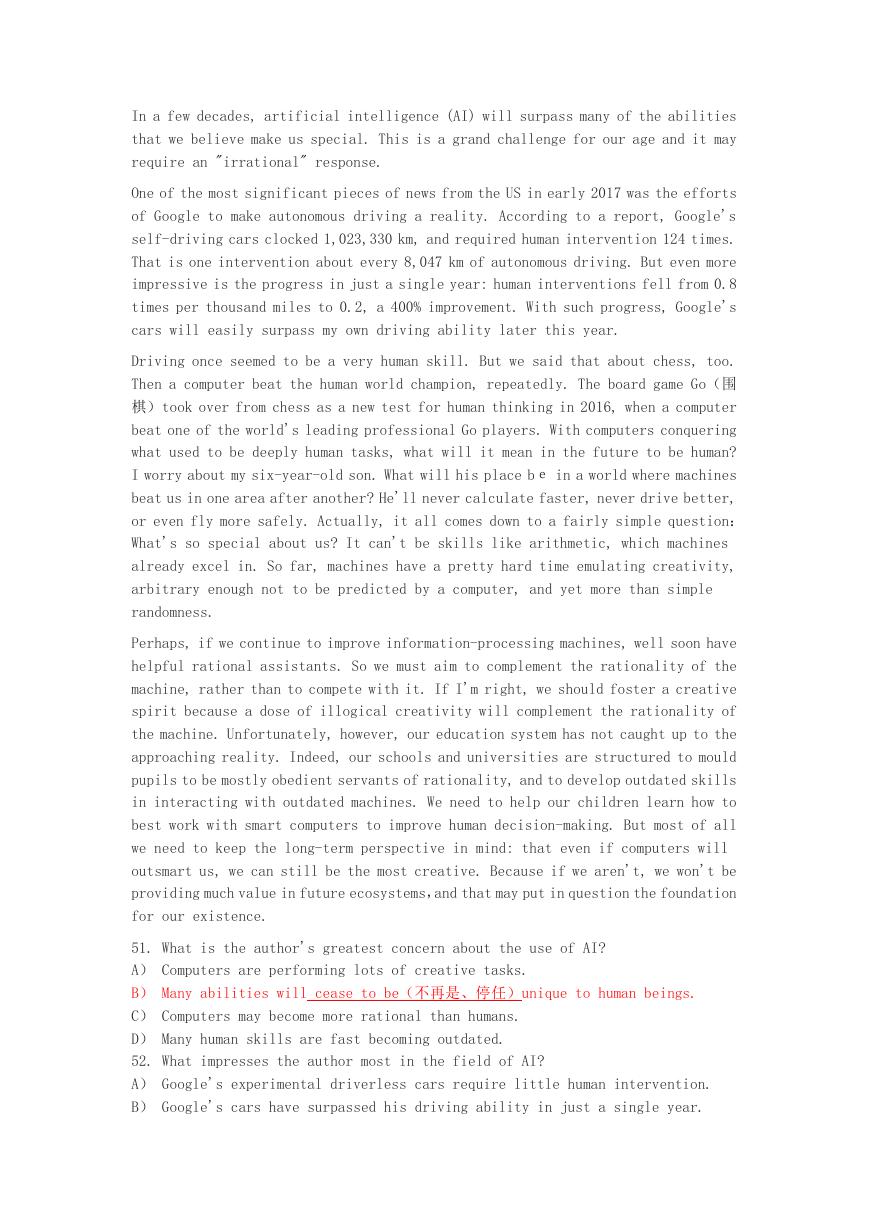








 2023年江西萍乡中考道德与法治真题及答案.doc
2023年江西萍乡中考道德与法治真题及答案.doc 2012年重庆南川中考生物真题及答案.doc
2012年重庆南川中考生物真题及答案.doc 2013年江西师范大学地理学综合及文艺理论基础考研真题.doc
2013年江西师范大学地理学综合及文艺理论基础考研真题.doc 2020年四川甘孜小升初语文真题及答案I卷.doc
2020年四川甘孜小升初语文真题及答案I卷.doc 2020年注册岩土工程师专业基础考试真题及答案.doc
2020年注册岩土工程师专业基础考试真题及答案.doc 2023-2024学年福建省厦门市九年级上学期数学月考试题及答案.doc
2023-2024学年福建省厦门市九年级上学期数学月考试题及答案.doc 2021-2022学年辽宁省沈阳市大东区九年级上学期语文期末试题及答案.doc
2021-2022学年辽宁省沈阳市大东区九年级上学期语文期末试题及答案.doc 2022-2023学年北京东城区初三第一学期物理期末试卷及答案.doc
2022-2023学年北京东城区初三第一学期物理期末试卷及答案.doc 2018上半年江西教师资格初中地理学科知识与教学能力真题及答案.doc
2018上半年江西教师资格初中地理学科知识与教学能力真题及答案.doc 2012年河北国家公务员申论考试真题及答案-省级.doc
2012年河北国家公务员申论考试真题及答案-省级.doc 2020-2021学年江苏省扬州市江都区邵樊片九年级上学期数学第一次质量检测试题及答案.doc
2020-2021学年江苏省扬州市江都区邵樊片九年级上学期数学第一次质量检测试题及答案.doc 2022下半年黑龙江教师资格证中学综合素质真题及答案.doc
2022下半年黑龙江教师资格证中学综合素质真题及答案.doc